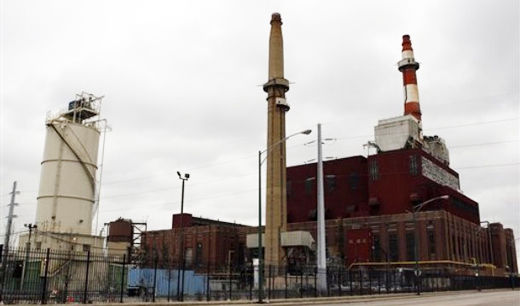
CHICAGO – There are two major coal-fired power plants here. One of them is Fisk Generating Station located in the Pilsen community and the other is the Crawford Generating Station located in the Little Village neighborhood. They’re both owned by Midwest Generation and both reside on the city’s southwest side in predominantly Mexican American working-class communities.
None of the power generated by these two power plants is actually sold to Illinois utility companies. The power is also used as an out-of-state liability resource during peak times.
Yet it’s Chicago residents that continue to suffer numerous health consequences due to the air pollution caused by both plants.
“I don’t think it’s fair that the we are suffering for something that is not benefiting us in anyway,” said Rafa Hurtado, a Little Village resident.
According to studies made between 2003-2004, both plants emit 230 pounds of mercury, which is known for causing brain damage. They also generate 17,756 tons of sulfur dioxide and nitrogen oxide, which can cause acid rain and eventually contributes to widespread asthma.
Harvard School of Public Health conducted a study estimating that the air pollution produced by Fisk and Crawford stations together is the cause of 2,800 asthma attacks, 550 emergency room visits, and 41 deaths a year.
“All I can say is wow. After seeing these facts it makes me so mad that this is happening to me and my people and nothing is being done about it,” said Enedina Elizondo, a senior citizen who has lived in Little Village her whole life.
Chicago has been dubbed the asthma center of the nation. The city’s asthma hospitalization rate is near double the national average. In some neighborhoods over 25 percent of children under the age of twelve suffer from asthma.
In 2007, both the Fisk and Crawford plants produced five million metric tons of carbon dioxide, a greenhouse gas emission that scientists have been proving for years impacts climate change. That’s equivalent to over 800,000 automobiles, critics note.
Because of their old age most Illinois coal-fired power plants are excluded from federal regulations that require modern pollution control devices.
The Fisk plant was rebuilt in 1958 and Crawford in 1959.
According to the 1977 Federal Clean Air Act both plants were supposed to be replaced by modern, cleaner plants in years to come.
But critics say little has changed over the years. The people that live near and around the plants continue to struggle with the lasting negative effects of air pollution.
Midwest Generation officials argue their policies meet federal and state standards and are adequate. The company says they even cut pollutants at the plants since acquiring them over a decade ago.
“Given the existing state and federal regulations protecting public health and the environment, an additional layer of regulation in Chicago is unnecessary and overreaching,” says the company.
“Its only real impact will be to risk the shutdown of these plants, and as a result, reliability of the electric grid and the loss of hundreds of good union jobs,” notes the company.
However 22nd Ward Alderman Ricardo Munoz from the Little Village area says what’s needed is to pass the Chicago Clean Power Ordinance in the City Council. Munoz along with Alderman Joe Moore, 49th Ward, are lead sponsors of the measure.
The ordinance was introduced in April to reduce emissions from Midwest Generation’s plants. It requires emissions of particulates and carbon dioxide from these plants to be reduced to levels equivalent to that of plants using natural gas, which is a cleaner burning fuel. A four-year phase-in process would give owners of the plants adequate time to comply.
“Climate change is one of the most urgent issues of our time,” said Munoz in a statement. “But Congress has failed to act. Chicago now must take the lead and use its home rule authority to clean up the Fisk and Crawford coal plants.”
Munoz added, “Chicago’s City Council needs to act now to protect our children’s future. This not only will reduce global warming pollution, but also will reduce the soot that comes from these smokestacks. This pollution is what contributes to asthma and other respiratory diseases in my ward and all of Chicago.”
Photo: http://geosci.uchicago.edu/~moyer/GEOS24705/Images/Crawford2.jpg












Comments